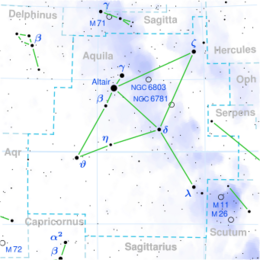Astronomy:Omega1 Aquilae
| Observation data Equinox J2000.0]] (ICRS) | |
|---|---|
| Constellation | Aquila |
| Right ascension | 19h 17m 48.99957s[1] |
| Declination | +11° 35′ 43.5234″[1] |
| Apparent magnitude (V) | 5.284[2] |
| Characteristics | |
| Evolutionary stage | subgiant[3] |
| Spectral type | F0 IV[4] |
| U−B color index | +0.204[2] |
| B−V color index | +0.238[2] |
| Astrometry | |
| Radial velocity (Rv) | −14.3[5] km/s |
| Proper motion (μ) | RA: +0.706[1] mas/yr Dec.: +13.947[1] mas/yr |
| Parallax (π) | 8.5341 ± 0.1401[1] mas |
| Distance | 382 ± 6 ly (117 ± 2 pc) |
| Absolute magnitude (MV) | −0.24[6] |
| Details | |
| Mass | 2.85±0.06[3] M☉ |
| Radius | 5.08+0.34 −0.25[1] R☉ |
| Luminosity | 84.7±1.6[1] L☉ |
| Temperature | 7,766+206 −245[1] K |
| Rotational velocity (v sin i) | 89[3] km/s |
| Other designations | |
| Database references | |
| SIMBAD | data |
Omega1 Aquilae, which is Latinized from ω1 Aquilae, is the Bayer designation for a single[8] star in the equatorial constellation of Aquila. With an apparent visual magnitude of 5.2[2] it is a faint, yellow-white hued star that can be seen with the naked eye in dark skies. From the annual parallax shift of 8.53 mas,[1] the distance to this star can be estimated as 382 light-years (117 parsecs), give or take a 6 light year margin of error. It is drifting closer to the Sun with a radial velocity of −14 km/s.[5]
The spectrum of this star fits a stellar classification of F0 IV.[4] Typically, a luminosity class of IV means that the star is in the subgiant stage. It is rotating rapidly with a projected rotational velocity of 115 km/s. This is causing an equatorial bulge that is 5% larger than the polar radius.[9] The star has 2.85[3] times the mass of the Sun and five[1] times the Sun's radius. It is radiating 85 times the luminosity of the Sun from its photosphere at an effective temperature of 7,766 K.[1]
References
- ↑ 1.00 1.01 1.02 1.03 1.04 1.05 1.06 1.07 1.08 1.09 1.10 Brown, A. G. A. (August 2018). "Gaia Data Release 2: Summary of the contents and survey properties". Astronomy & Astrophysics 616: A1. doi:10.1051/0004-6361/201833051. Bibcode: 2018A&A...616A...1G. Gaia DR2 record for this source at VizieR.
- ↑ 2.0 2.1 2.2 2.3 Gutierrez-Moreno, Adelina et al. (1966), "A System of photometric standards", Publications of the Department of Astronomy University of Chile (Publicaciones Universidad de Chile, Department de Astronomy) 1: 1–17, Bibcode: 1966PDAUC...1....1G.
- ↑ 3.0 3.1 3.2 3.3 Zorec, J.; Royer, F. (2012), "Rotational velocities of A-type stars. IV. Evolution of rotational velocities", Astronomy and Astrophysics 537: A120, doi:10.1051/0004-6361/201117691, Bibcode: 2012A&A...537A.120Z.
- ↑ 4.0 4.1 Cowley, A. et al. (April 1969), "A study of the bright A stars. I. A catalogue of spectral classifications", Astronomical Journal 74: 375–406, doi:10.1086/110819, Bibcode: 1969AJ.....74..375C.
- ↑ 5.0 5.1 Wielen, R. et al. (1999), "Sixth Catalogue of Fundamental Stars (FK6). Part I. Basic fundamental stars with direct solutions", Veroeffentlichungen des Astronomischen Rechen-Instituts Heidelberg (Astronomisches Rechen-Institut Heidelberg) 35 (35): 1, Bibcode: 1999VeARI..35....1W.
- ↑ Anderson, E.; Francis, Ch. (2012), "XHIP: An extended hipparcos compilation", Astronomy Letters 38 (5): 331, doi:10.1134/S1063773712050015, Bibcode: 2012AstL...38..331A.
- ↑ "ome01 Aql". SIMBAD. Centre de données astronomiques de Strasbourg. http://simbad.u-strasbg.fr/simbad/sim-basic?Ident=ome01+Aql.
- ↑ Eggleton, P. P.; Tokovinin, A. A. (September 2008), "A catalogue of multiplicity among bright stellar systems", Monthly Notices of the Royal Astronomical Society 389 (2): 869–879, doi:10.1111/j.1365-2966.2008.13596.x, Bibcode: 2008MNRAS.389..869E.
- ↑ van Belle, Gerard T. (March 2012), "Interferometric observations of rapidly rotating stars", The Astronomy and Astrophysics Review 20 (1): 51, doi:10.1007/s00159-012-0051-2, Bibcode: 2012A&ARv..20...51V.
External links
 |


